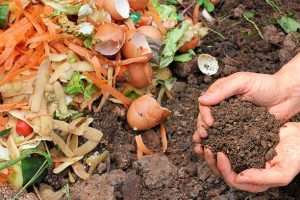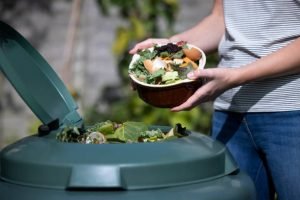How to Compost: A Guide to Composting at Home
Composting at home is the decomposition of organic matter, such as leaves and food scraps, into the soil. The most important supplement you can give your garden is compost. It’s an easy way to add nutrient-rich humus to your lawn or garden, which promotes plant growth and revitalizes depleted soil. It’s also free, simple to make, and environmentally friendly. However, there are additional advantages to composting.
It’s an excellent way to recycle yard and kitchen scraps while also enriching the soil in your garden, improving water retention, and preventing erosion.

What is composting?
Composting is the process of converting food scraps into usable soil. It’s actually pretty cool—microorganisms collaborate to break down organic materials (such as leftover stems, fruit peels, and eggshells) to create a rich soil that provides plenty of nutrients to a variety of plants. It can significantly reduce the amount of food waste you send to a landfill.
What can be composted?
Food scraps, lawn trimmings, and a variety of other organic materials can all be composted.
Here are some examples of compostable items:
- Fruit and vegetable peels and scraps
- Rotten fruit and veggies
- Houseplant trimmings
- Coffee grounds and paper filters
- Tea leaves
- Eggshells
- Nutshells (apart from walnuts)
- Hair and fur
- Paper, cardboard, and shredded newspaper
- Napkins, paper towels, and unused toilet paper
- Grass clippings
- Leaves
- Flowers
- Sawdust
- Wood chips
What can’t be composted?
Not everything in your kitchen or yard should be composted. Some items, in fact, may attract pests and rodents, while others contain harmful chemicals.
Here are some things you should not compost:
- Meat & fish scraps
- Dairy
- Fats, grease, and oils
- Pet waste
- Human waste
- Diseased plants
- Yard waste treated with chemicals
- Black walnut tree branches
How to start composting at home:

Here’s a step-by-step guide to start composting at home.
Materials:
- A compost bin that’s ideally at least one cubic yard (three feet by three feet). You can buy one or make your own.
- A mixing device, such as a shovel or pitchfork
- Brown matter
- Green matter
- Water
Step-by-Step Guide:
- Start your compost pile on bare ground. Worms and other beneficial organisms can then aerate the compost and move it to your garden beds.
- First, lay twigs or straw a few inches deep. This improves drainage and aerates the pile.
- Layer compost materials, alternating moist and dry. Food scraps, tea bags, seaweed, and other moist ingredients are examples.
- Manure, green manure (clover, buckwheat, wheatgrass, grass clippings), or any other nitrogen source can be added. This activates the compost pile and accelerates the process.
- Maintain the moisture level in the compost. Water infrequently or let the rain do the work.
- Cover with anything you have- Covering also keeps rain from over-watering the compost. The compost should be moist but not saturated.
- Turn- Give the pile a quick turn with a pitchfork or shovel every few weeks. This helps to aerate the pile. The process requires oxygen to function, and turning “adds” oxygen. If you have a ready supply of coarse material, such as straw, you can skip this step.
- After you’ve established your compost pile, mix in new materials rather than adding them in layers. Turning or mixing the compost pile is essential for aerating the composting materials and speeding up the composting process.
Tips & tricks:
- Consider the size of the materials you throw in your compost. “While it is not required, materials that are cut up or shredded will decompose faster than materials that are left in their original shape.”
- If you notice that a particular type of scrap is taking a long time to break down, cut it into small pieces before placing it in your bin.
- Always maintain a healthy balance of green and brown components.
- Remember, you don’t have to go it alone!
The bottom line:
Composting is a simple and effective way to fight food waste while also lowering your environmental impact. It also encourages plant growth by enriching the soil, preventing erosion, and decreasing the need for synthetic fertilizers in your garden.
Thank you for reading…
